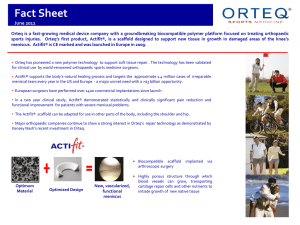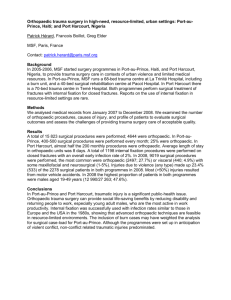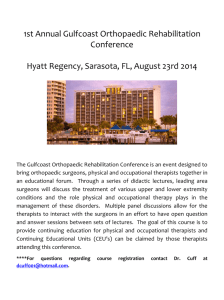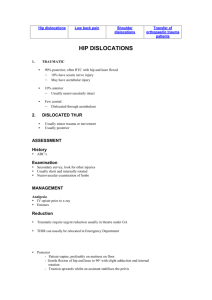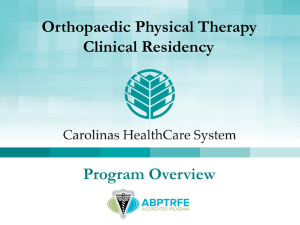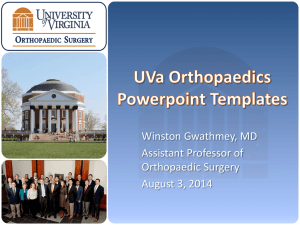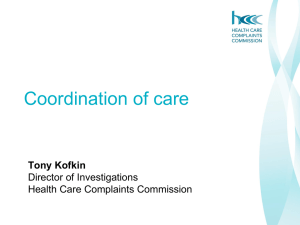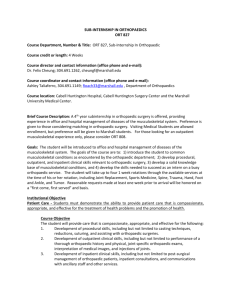Orthopaedic Surgery Course Overview – Ortho 658
advertisement
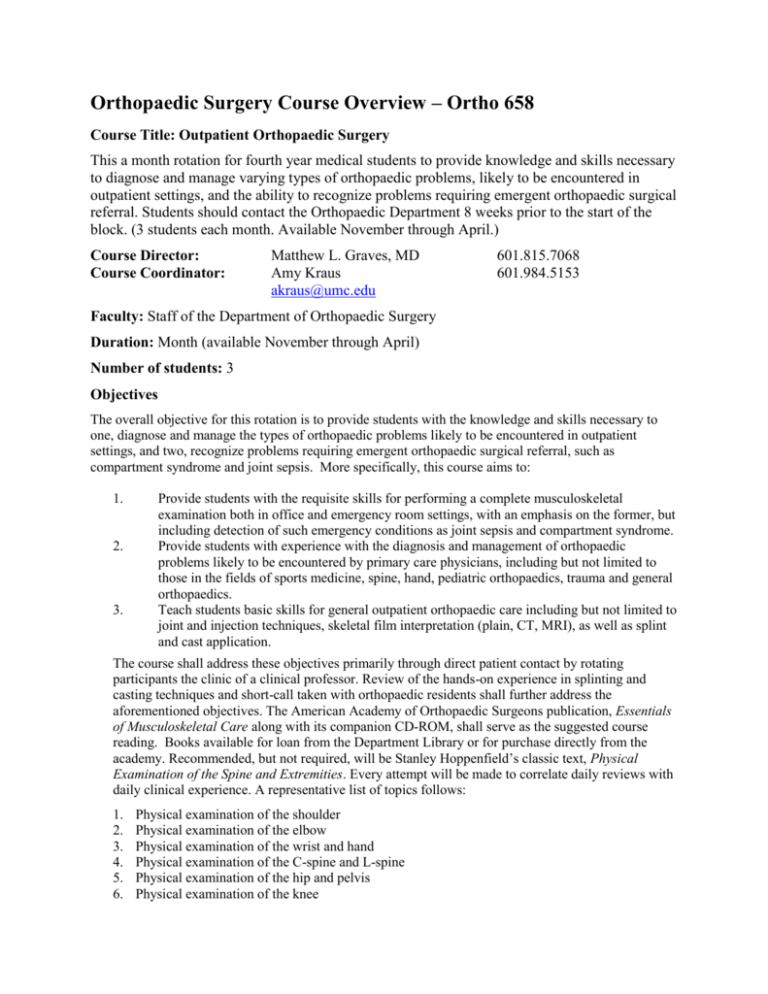
Orthopaedic Surgery Course Overview – Ortho 658 Course Title: Outpatient Orthopaedic Surgery This a month rotation for fourth year medical students to provide knowledge and skills necessary to diagnose and manage varying types of orthopaedic problems, likely to be encountered in outpatient settings, and the ability to recognize problems requiring emergent orthopaedic surgical referral. Students should contact the Orthopaedic Department 8 weeks prior to the start of the block. (3 students each month. Available November through April.) Course Director: Course Coordinator: Matthew L. Graves, MD Amy Kraus akraus@umc.edu 601.815.7068 601.984.5153 Faculty: Staff of the Department of Orthopaedic Surgery Duration: Month (available November through April) Number of students: 3 Objectives The overall objective for this rotation is to provide students with the knowledge and skills necessary to one, diagnose and manage the types of orthopaedic problems likely to be encountered in outpatient settings, and two, recognize problems requiring emergent orthopaedic surgical referral, such as compartment syndrome and joint sepsis. More specifically, this course aims to: 1. 2. 3. Provide students with the requisite skills for performing a complete musculoskeletal examination both in office and emergency room settings, with an emphasis on the former, but including detection of such emergency conditions as joint sepsis and compartment syndrome. Provide students with experience with the diagnosis and management of orthopaedic problems likely to be encountered by primary care physicians, including but not limited to those in the fields of sports medicine, spine, hand, pediatric orthopaedics, trauma and general orthopaedics. Teach students basic skills for general outpatient orthopaedic care including but not limited to joint and injection techniques, skeletal film interpretation (plain, CT, MRI), as well as splint and cast application. The course shall address these objectives primarily through direct patient contact by rotating participants the clinic of a clinical professor. Review of the hands-on experience in splinting and casting techniques and short-call taken with orthopaedic residents shall further address the aforementioned objectives. The American Academy of Orthopaedic Surgeons publication, Essentials of Musculoskeletal Care along with its companion CD-ROM, shall serve as the suggested course reading. Books available for loan from the Department Library or for purchase directly from the academy. Recommended, but not required, will be Stanley Hoppenfield’s classic text, Physical Examination of the Spine and Extremities. Every attempt will be made to correlate daily reviews with daily clinical experience. A representative list of topics follows: 1. 2. 3. 4. 5. 6. Physical examination of the shoulder Physical examination of the elbow Physical examination of the wrist and hand Physical examination of the C-spine and L-spine Physical examination of the hip and pelvis Physical examination of the knee 7. 8. 9. 10. 11. 12. 13. 14. 15. 16. 17. 18. 19. 20. 21. 22. 23. Physical examination of the foot and ankle Acute compartment syndrome Fracture principles Musculoskeletal imaging techniques Soft-tissue injections and corticosteroids Orthopaedic trauma and long bone fractures Commonly missed orthopaedic fractures (e.g. scaphoid, Lisfranc) Sports injuries of the knee (e.g. ACL, meniscus, osteochondral fx, patellar dislocation) Sports injuries of the knee (e.g. RC, glenohumeral instability) Commonly encountered wrist pathology (e.g. carpal tunnel syndrome, ganglion, scaphoid fx, Kienbock’s z, tenosynovitis) Hip dislocation, fx and replacement Selected hip topics including: osteoarthritis, osteonecrosis, trochanteric bursitis & snapping hip Selected pediatric topics including SCFE, DDH, and adolescent idiopathic scoliosis) Low Back pain (e.g. spinal stenosis, HNP & sciatica, disc infection and metastatic scoliosis) Selected foot and ankle topics including sprain, plantar fasciitis, care of the diabetic foot, hallux valgus, mallet toe & hammer toe. C-Spine trauma Septic joint Hands on splinting opportunities will provide students with experience applying various types of commonly used plaster splints, including sugar tong, coaptation, radial & ulnar gutter, volar, long leg posterior and short leg posterior splints. Attendance of the weekly Tuesday morning orthopaedic conference/grand rounds will be mandatory if the student is assigned to clinic in the Jackson area. Within the outpatient environment, students shall bear responsibility for the initial evaluation of patients including formulation of a diagnosis and management strategy, overseen by orthopaedic faculty. Students shall be given the opportunity to perform fundamental orthopaedic outpatient procedures, such as joint aspiration and injection and cast application and revision when available. Additional clinical responsibilities (at the discretion of the clinical professor) will include short –call, taken on a weekly basis and encompassing a time period beginning with the end of the student’s afternoon clinic and ending at midnight. The short-call experience will emphasize emergency room treatment of acute orthopaedic injuries and will help familiarize students with the types of problems requiring emergent orthopaedic referral. While students would be under no obligation to accompany residents or faculty to the operating room should the occasion arise, they will be encouraged to do so in order to gain basic exposure to techniques or the open reduction and internal fixation of fractures. Course Outline The student is assigned to an orthopaedic staff member for a period of one month, thus having the opportunity to participate in the treatment of a variety of orthopaedic conditions. The student will work with and assist the attending in the clinics. He/she also attends the weekly didactic teaching conferences of the department and of the subspecialty. The student will also attend monthly Journal Clubs. Method of Evaluation The student is evaluated through Formative and Summative electronic evaluations setup in E*Value. The final grade is a compilation of the evaluations received from the orthopaedic surgeons and residents to whom he/she has been assigned. The student is asked to evaluate the program and the faculty at the end of the rotation. Grading Scale based on Core Competencies Patient Care Medical Knowledge Practice-Based Learning Interpersonal & Communication Skills Professionalism System-Based Practice TOTAL 16.6 % 16.6 % 16.6 % 16.6 % 17.0 % 16.6 % 100 % Professional Demeanor and Appearance It is expected that the demeanor and personal appearance of the medical student will reflect quality professionalism and pride in all the roles in which the student finds himself or herself. In addition to the student’s clinical skills and technical abilities, the way we “present” to other people is the crucial element in earning the confidence and respect that is so important to successful patient and professional relationships. The following practices should be observed: Dress A coat and tie or professional attire must be worn at all times, including weekend with the exception of night call. Bloody athletic shoes are not considered acceptable attire. Conduct 1. Attendance is expected at all scheduled conferences and clinics unless specifically excused by the Chief Resident or Staff. 2. Hospital rules for smoking will be observed. In addition, simple courtesies such as no gum chewing or eating during patient contact or while presenting are observed. 3. Everyone with whom the student comes in contact is to be treated courteously. Do not respond to irritating behavior with an angry response; nothing positive is accomplished. Rather, submit the problem areas to the Chief Resident or Staff as appropriate. 4. Do not take up personal vendetta with any office, position or person. Be honest and candid and use sound judgment and discretion. When we fail in our interpersonal contacts, the best remedy is to seek forgiveness. It is professional and reflects mature character to say “I’m sorry”. 5. Be especially courteous to nurses and ancillary personnel Core Competencies Patient Care Student will gain abilities to evaluate patients with musculoskeletal injuries. Students must be able to provide patient care that is compassionate, appropriate, and effective for the treatment of health problems and traumatic injuries. Students are expected to demonstrate an understanding and delivery of basic patient care including respect for patient autonomy and appropriate bedside manner. They will be expected to generate patient lists for the services assigned, and use these lists to develop comprehensive assessments and plans for patients admitted to the services. All should be able to recognize critical lab abnormalities or clinical situations that will require a higher level of care. Medical Knowledge Student will gain knowledge in anatomy; and fracture management principles and outcomes. Students must demonstrate knowledge of established and evolving biomedical, clinical, epidemiological, and socialbehavioral sciences, as well as the application of this knowledge to patient care. Practice- Based Learning and Improvement Students must demonstrate the ability to investigate and evaluate the care of patients, to appraise and assimilate scientific evidence, and to continuously improve patient care based on constant self-evaluation and life long learning. Students are expected to develop skills and habits to be able to: Identify strengths, deficiencies and limits in one’s knowledge and expertise; Set learning and improvement goals Use information technology to optimize learning All students will be expected to be “active learners,” asking questions routinely on rounds and demonstrating incorporation of new knowledge into their patient care plans. They will be expected to demonstrate regular use of the medical literature in determining evidence basis for recommended therapies in a variety of orthopedic clinical scenarios. All students will be expected to answer clinical questions through use of available electronic resources. Systems Based Practice Students must demonstrate an awareness of and responsiveness to the larger context and system of health care, as well as the ability to call effectively on other resources in the system to provide optimal health care. Students are expected to coordinate patient care within the health care system relevant to the care of the orthopedic patient. Incorporate considerations of cost awareness and risk-benefit analysis in patient care. Work in interprofessional teams to enhance patient safety and improve patient care quality. Professionalism Students must demonstrate a commitment to carrying out professional responsibilities and an adherence to ethical principles. Students are expected to demonstrate: Compassion, integrity, and respect for others Responsiveness to patient needs that supersedes self-interest Respect for patient privacy and autonomy Sensitivity and responsiveness to a diverse patient population, including but not limited to diversity in gender, age, culture, race, religion, disabilities, and sexual orientation Interpersonal and Communication Skills Students must demonstrate interpersonal and communication skills that result in the effective exchange of information and teaming with Residents and Staff. Students will gain an appreciation of the importance of good communication skills with patients with musculoskeletal complaints.
